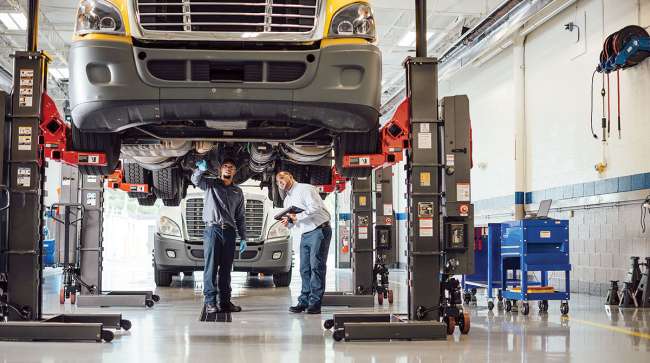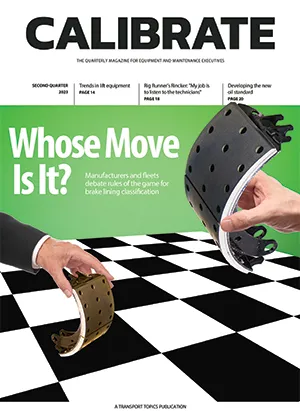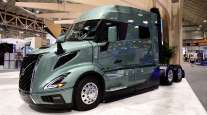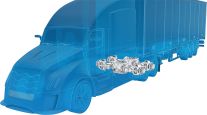Contributing Writer
Getting a Lift: Fleets Weigh Lift Equipment

[Find the latest in equipment & maintenance: Explore this quarter's issue of Calibrate]
Penske Truck Leasing has a simple strategy for heavy-duty vehicle lifts in its shop network: Mobile is better. Adam Sands, the trucking company’s manager of tooling, service bay technology and optimization, said mobile column lifts offer greater flexibility and adaptability and can be moved to different bays, or even to a customer’s location.
“Moving it around would allow us to be more productive with less equipment potentially where, for example, we could raise the vehicle to desired height with a mobile column lift, put it on specific jack stands for that application, and then use it in another application,” Sands said.
Those advantages have enabled Penske to reach its productivity goals. They are important qualities for a company where 10,400 technicians maintain 416,000 vehicles at more than 900 truck leasing locations in North America.
Penske, which ranks No. 15 on the Transport Topics Top 100 list of the largest for-hire carriers in North America, does use stationary two-post and four-post lifts at some locations, but those are primarily for vehicles other than heavy-duty ones. The company didn’t reach its conclusions by happenstance. Various lift types were tested at Penske’s Technology and Education Center (PTEC), in Reading, Pa. The data showed mobile column lifts best met its needs.
Michael V. Rozzi, product manager for heavy-duty lifting equipment for manufacturer Vehicle Service Group, said mobile column lifts are the largest and fastest growing lift market segment for heavy-duty trucking. Their popularity has grown because of their flexibility. Mobile column lifts don’t have to be installed or bolted to the floor. They can be used to create an outside bay on a sturdy concrete pad, and can be stored when not in use.

Rozzi
“These really don’t have the financial impact on your bottom line due to the reduced installation costs,” Rozzi said. “You can purchase these, wheel them into your shop and start using them.”
Platform lifts and four-post lifts have their own advantages, including ease of use and convenience, he added. Vehicles can be driven onto and off of them, so they are good for preventive maintenance and inspections.
Two-post lifts are a bit cheaper and flexible. They can handle a variety of vehicles within a fleet, and also give technicians easy access to wheels and brakes. However, they are not as convenient for inspections and preventive maintenance because of the time required for setup.
Rozzi pointed out that lifts, whatever their type, have advantages over old-fashioned creepers. Lifts are more ergonomic and can reduce technician injuries. Fleets with lifts will find it easier to find qualified technicians at a time when those are in short supply, he explained.
R.W. “Bob” O’Gorman, president of the Automotive Lift Institute (ALI), said there have been many changes in the lifting industry the past few years. More manufacturers are offering two-post surface lifts to serve medium-duty trucks. Manufacturers are incorporating more electronics in order to add features.
There also has been an increased emphasis on annual inspections. ALI recommends annual full inspections by an ALI-approved inspector, but fleets should consider manufacturer recommendations and their use patterns to determine if they need closer intervals. A comprehensive Check360 Certified Lift Inspection — conducted by an ALI-certified lift inspector — will meet all ALI safety standard requirements. The inspector will apply to the lift a serialized label indicating it passed.

O'Gorman
O’Gorman encourages fleets to buy only ALI-certified lifts that have been independently tested by a nationally accredited testing laboratory. Installing uncertified lifts is a violation of the International Building Code, as well as state and local regulations.
While Penske is far along in its lift-purchasing strategy, Yellow has started moving in that direction. The company known as YRC Worldwide until 2021 has been reorganizing and streamlining its maintenance practices after purchasing several regional carriers. It ranks No. 10 on TT’s Top 100 for-hire list.
Mike Grima, Yellow’s vice president of equipment services, said the company is planning a major investment in lifts in the coming years after it evaluates which of its facilities can accommodate them. It currently is using primarily creepers and jacks.
Grima said Yellow will be adding four-post lifts throughout its network to create a drive-on, drive-off assembly line environment like the one he operated at a previous carrier. Trucks will drive forward onto dual ramps without having to back on or off.
Chris Carter, vice president of maintenance at XPO, said when his company selects a lift, it considers both its current and future needs. Factoring into the decision are ease of operation, ergonomics, the ability to reposition mobile lifts, and other considerations. XPO ranks No. 3 on TT’s Top 100 for-hire list, and No. 6 on the Transport Topics Top 100 list of the largest logistics companies in North America.
“Most importantly, ask the technicians what they prefer since they’re the ones working with the equipment and understand what’s needed to service vehicles most efficiently and safely,” he added.
Lift Equipment Considerations
Rozzi said fleets purchasing lifting equipment should understand what services are required in their shop. The shop manager might want a different type of lift in each bay that is dedicated to a certain type of service — for example, a platform lift for preventive maintenance in one bay and a two-post lift for wheel work in another. They should look for a manufacturer with a network that can provide service after the sale and, if possible, has a service location nearby. The manufacturer should offer training before the lift is commissioned through its installer network.
Rozzi said fleets should consider where their business will be going, not simply where it is at that point.
More Q2 Calibrate
►Standard Sought for Brake Lining Classification
►Freeze: Participating in the Right to Repair Debate
►Fleets Weigh Lift Equipment
►5 Questions With Rig Runner's Jay Rincker
►Baxter: New Oil Standard Will Help Fleets
►TMC Corner: The Evolution of Tractor-Trailer Connectivity
Explore the Issue!
“The types of services that your facility performs or will perform in the future are important considerations when choosing your lifts,” he said. “Typically, what we see is the equipment is getting bigger and heavier and can do more, so if you’re looking three, five to 10 years down the road, you may want to look where your shop wants to be at then, because you’re going to be owning this equipment for a while.”
A future consideration for some heavy-duty fleets — and a growing current one for some medium- and light-duty fleets — is how much they plan to use electric vehicles. Lifts that work with internal combustion engine-powered trucks won’t necessarily be a good fit for electrical ones because of the battery’s location beneath the cab, Rozzi said.
Penske has already started using light-, medium- and heavy-duty electric vehicles, including Class 8 Freightliner eCascadias, that are being serviced at its facilities. The PTEC facility works with manufacturers to decide how it will need to adapt before the product hits the field.
Once a fleet has selected and installed a lift, it must maintain and operate it properly. Lift manufacturers include preventive maintenance time frames in their operations manuals. As part of Grima’s previous company’s routine maintenance schedule, inspections were done by company employees trained by lift manufacturers, while repairs were vended out. Technicians were looking for frayed cables and leaking cylinders, and were ensuring all four corners were engaging simultaneously.
As for daily operations, Rozzi said a common mistake technicians make is not using proper lifting points. O’Gorman warned against overloading a lift beyond its rated load capacity. Removing heavy components after a vehicle is in the air can alter its center of gravity and cause it to shift. High-reach vehicle support or supplementary stands can help stabilize the vehicle. Other common mistakes include improperly loading the vehicle onto the lift, failing to chock the wheels on a drive-on lift, and using homemade adapters like wood blocks.
“The solution to most of these common mistakes is operator training and putting safety first, not taking shortcuts,” he said.
XPO trains technicians to do pre-check inspections not only before each shift but before each use, Carter said. Technicians confirm that the lifts are properly positioned and that sufficient space is available. The process is repeated when the vehicle is lowered. Mistakes can be avoided by providing technicians with proper training and consistent checkpoints, such as using a spotter to ensure vehicles are properly aligned when driving onto a lift. Technicians are trained to ensure lifts are placed at the proper height so they can move safely beneath them. They also are trained to ensure weight ratings can always be identified on equipment because lift decals can easily wear off.
“Finally, and this may seem like an obvious one, we prioritize keeping shops clean and organized at all times,” Carter said. “This helps to promote a culture of shop safety that reinforces the safe use of lifts.”
Want more news? Listen to today's daily briefing below or go here for more info:





